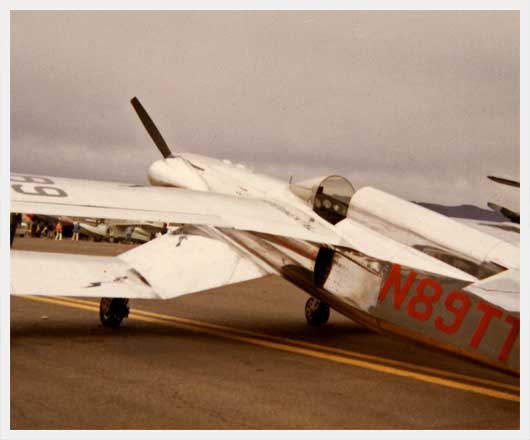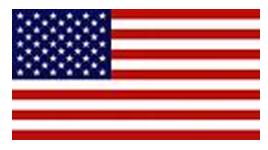Sorceress: Radical Sport Biplane Racer At Reno 1970
 Friday, December 2, 2011 at 10:06PM
Friday, December 2, 2011 at 10:06PM  (click pic to enlarge) The very radical Sorceress biplane racer at Reno in 1970
(click pic to enlarge) The very radical Sorceress biplane racer at Reno in 1970
(3 pix)
I've been quiet about the Reno Air Races since shortly after the tragic crash of Jimmy Leeward in The Galloping Ghost that took his life and the lives of 10 people in the stands, along with injuring many more. Time has the ability to settle much of the shock of an event like this, but obviously there are many people for which this tragedy will forever define the rest of their life. For all of us though, regardless of how much time passes, it just seems like the kind of occurrence that we will never be able to make any sense out of. This is the reality of much of life... things happen that we would never dream of, and pain and confusion are the result. But if there's one thing that seems to be clear, even in the face of tragedy, it's that life goes on.
It's with this idea in mind that I'm sharing these pictures from Reno in 1970 of one of the most unique aircraft ever to show up to the races. There's a long and very rich history since the races began in 1964, and it feels like looking back is one of the best ways to look to the future.
Sorceress arrived at Reno to shake up the Sport Biplane Class, but according to the amazing race history book Racing Planes & Air Races 1968-1971 (by Kinert), Sorceress did fly, but the lack of time on the aircraft put it in the position of a fill-in and was only allowed to finish in last place. I was fortunate to be at these races in 1970 as a 9 year old, and my dad took these pictures as we were able to see Sorceress up close. I knew it was a big deal even as a kid to see this game changing racer, but I don't have any memory of how the races turned out. I'm so thankful to have this book (and the previous edition that covers the years 1909-1967) to be able to re-experience some of the history that I witnessed from 1967 to 1970. These two books are highly recommended.
 (click pic to enlarge) Sorceress: All metal, negative stagger, and inverted gull lower wing
(click pic to enlarge) Sorceress: All metal, negative stagger, and inverted gull lower wing
1970 was the year that both Sorceress (with pilot and designer Lee Mahoney) and the Hot Canary (with pilot and designer Bill Warwick) showed up in the biplane class as purpose built racers. Typically the biplanes were modified Pitts Specials, Mong Sports, or Smith Miniplanes, but a handful of race teams were working on introducing a whole new generation of two-winged racers. It was a very exciting time, especially because these aircraft added a lot of intrigue to the races. They also showed the promise of being able to push the speeds up significantly higher once they were tuned and tweaked. The speeds for Sorceress were nothing special in this first outing (around 154 mph) but the airplane did cross the finish line first in the consolation race, but again, as a fill-in, it still officially took last place. Hot Canary was already showing itself to be quite fast with a qualifying speed of almost 172 mph... and finished in fourth place in the championship race, just barely being beat out for third by a Miniplane. The fastest qualifier in 1970 was Bill Boland in a Mong at almost 182 mph. All these speeds were pretty impressive for open cockpit biplanes running on stock Lycoming O-290 engines.
These two new and unique biplane racers were definitely showing the more standard racers that they were serious about pushing the speeds up and changing the class forever. I admit that my details on what follows are cloudy, and I hope to be able to get some good and accurate info in the future, but it seems that there was an effort within the race community to exclude Sorceress from being able to race. The rules may have been changed to effectively push the airplane out of the class. I'm sure there's a lot to the story, but to me, purpose built biplanes that creatively found ways to go faster would have really ignited the class. I wish the biplane racers today were more diverse and more unique than the surprisingly ordinary batch of racers seen still today. Interestingly, the biplane to beat these days is Tom Aberle’s highly modified Mong Sport known as Phantom (you'd never think it a Mong to look at it) and it's not like the ordinary racers at all... and that's why it's so much faster than everything else.
 (click pic to enlarge) A closer view of Sorceress at the Reno Air Races in 1970
(click pic to enlarge) A closer view of Sorceress at the Reno Air Races in 1970
But the real point of this post is just to realize what an amazing culture shock Sorceress was. With its all metal construction, negative stagger biplane configuration, inverted gull lower wing, and an overall look that screamed I'm not like you... this airplane was about as far away from the ordinary racers as you could get. And while I couldn't remember how the races that year had turned out for the airplane, I do remember that its appearance at the races really did electrify. People were definitely talking about Sorceress, and even as a kid I was really glad to see that innovation was in the pipeline. I was also a big fan of the Hot Canary, and I've also got a few pictures of that unique biplane racer to share sometime in the future.
Ultimately, I'm hopeful that the spirit of the Reno Air Races from the past will help us see what the future of the races will be. I believe they represent the very nature of mankind... to push ourselves, to go faster, and to go to places we once only dreamed of. This is what the Reno Air Races mean to me.
Sorceress is now on display at the National Air and Space Museum
 Martt |
Martt |  2 Comments |
2 Comments | 













































































Reader Comments (2)
Thanks Martt. It reminded me of Burt Rutan's biplane Model 68 Amsoil Racer which had very flexible struts added to the wings just to meet the configuration rules for the racing class.
Hi Matt, by chance would you happen to have any photos of another plane in the race that year. It was called Johnathon Livingston Seagull .I purchased the plane a few years back and and this year I retired so now I want to restore it back to its original condition .It to sported the gull wing design only on the top wing. I believe it won second place. And raced in 1970,71,and 72. Any info or photos would really help. I can't wait to get started. Thanks